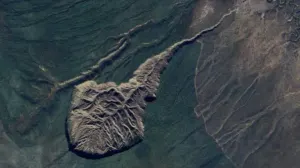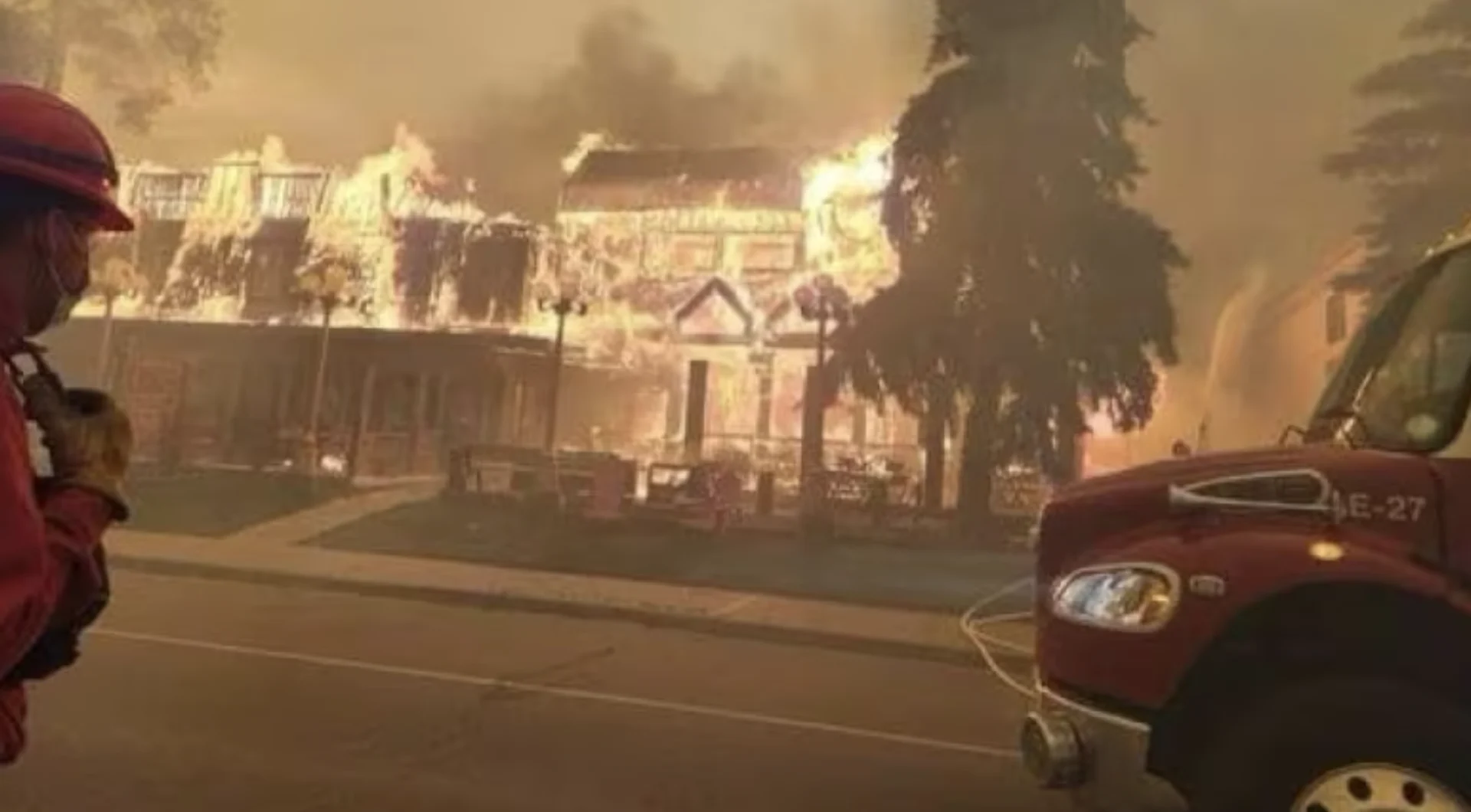
Buildings in Jasper in ashes after 'monster' wildfire rips through community
CANADA'S WILDFIRES: Visit The Weather Network's wildfire hub to keep up with the latest on the active wildfire season across Canada.
A wildfire that roared into the community of Jasper, Alta., late Wednesday has left vast stretches of the townsite incinerated.
Video shared to social media on Thursday shows blocks upon blocks of buildings have been levelled by fire.
The video, taken from inside a truck, shows a view of a community forever changed.
Where buildings once stood, charred rubble remains. Many homes in the historic townsite have been destroyed, leaving only the foundations.
The video shows vehicles blackened by fire lining the streets. Scorched trees stand like matchsticks. Flashing vehicle lights flare red over the low chatter of an emergency radio.
The truck pauses briefly in front of one of the burned homes and a man's voice can be heard saying, "That's Mom and Dad's house."
CBC has verified that the video shows Geikie Street and Larch Avenue.
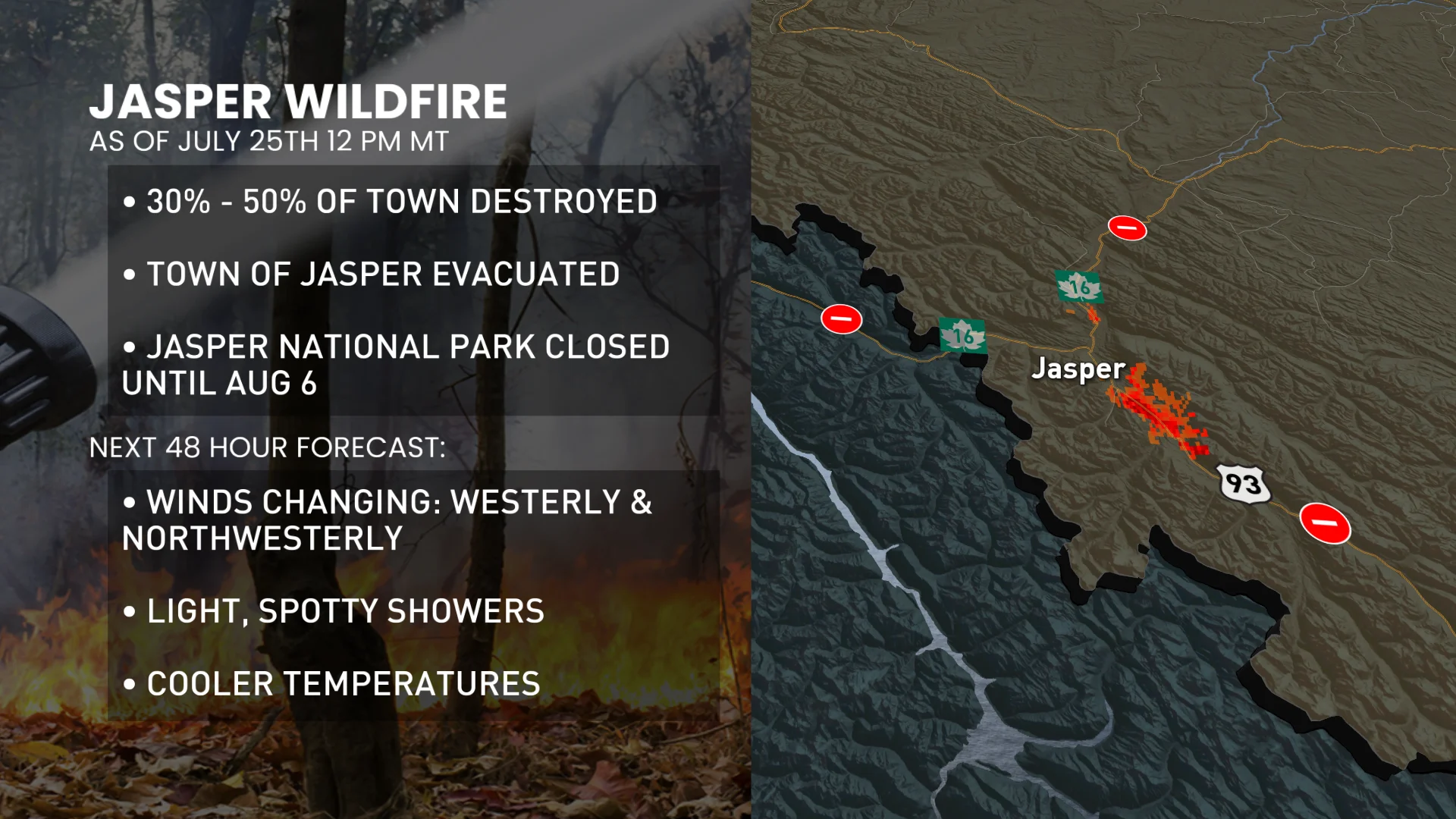
SEE ALSO: Best practices to keep yourself safe from wildfire smoke
Officials with Parks Canada declined to comment on the scale of the destruction but have confirmed that many buildings in the historic townsite have been lost to a fire so powerful it eventually chased first responders out of the community.
Pierre Martel with Parks Canada said wind-whipped flames sent embers raining down on the townsite, sparking spot fires as it advanced.
"What you're dealing is just a monster at that point," Martel said during a news conference Thursday.
"There are no tools we have in our toolbox to deal with that. At that point, you get out of the way, you retreat, and you do what you can to protect communities and infrastructure as best as we can."
Firefighters had scrambled through the night to save the homes and businesses as a relentless and powerful fire breached the outskirts of town.
Martel said crews will be fighting the fire for weeks before it's under control, and even longer before it will be extinguished.
The fire, one of two that had been threatening Jasper, moved in on Wednesday evening, consuming homes and businesses in a wall of flame.

Donate online at redcross.ca
During a news conference Thursday, Premier Danielle Smith said the full extent of the damage is unknown but a large portion of the townsite has been destroyed.
Images coming out of Jasper are "horrific," she told reporters.
"We are seeing potentially 30 to 50 per cent structural damage," Smith said. "You have seen the images, as I have. We don't know particularly which structures have been damaged and which ones have been destroyed but that is going to be a significant rebuild."
Smith broke down in tears at the podium as she spoke about the beauty of Jasper and the loss that residents are experiencing. She said she has been in contact with her federal counterparts and local government. The province is committed to assisting evacuees and the community, she said.
"We will recover from this," she said.
Smith also expressed gratitude to firefighters who continue battling the flames that burn out of control. The wildfire, whipped into a firestorm by intense winds, burned with such intensity and speed that plumes of ash and flames shot hundreds of feet into the air.
The wildfire, whipped into a firestorm by intense winds, burned with such intensity and speed that plumes of ash and flames shot hundreds of feet into the air.
James Eastham, a Parks Canada wildfire information officer, said firefighters were faced with a wall of flame that proved impossible to contain.
"Fire behaviour was intense," Eastham said in an interview Wednesday.
"Fire crews were witnessing 300- to 400-foot flames in a fully involved, continuous crown fire and a fire spread rate of approximately 15 metres per minute."
RELATED: Thousands of tourists among those forced to flee Jasper National Park
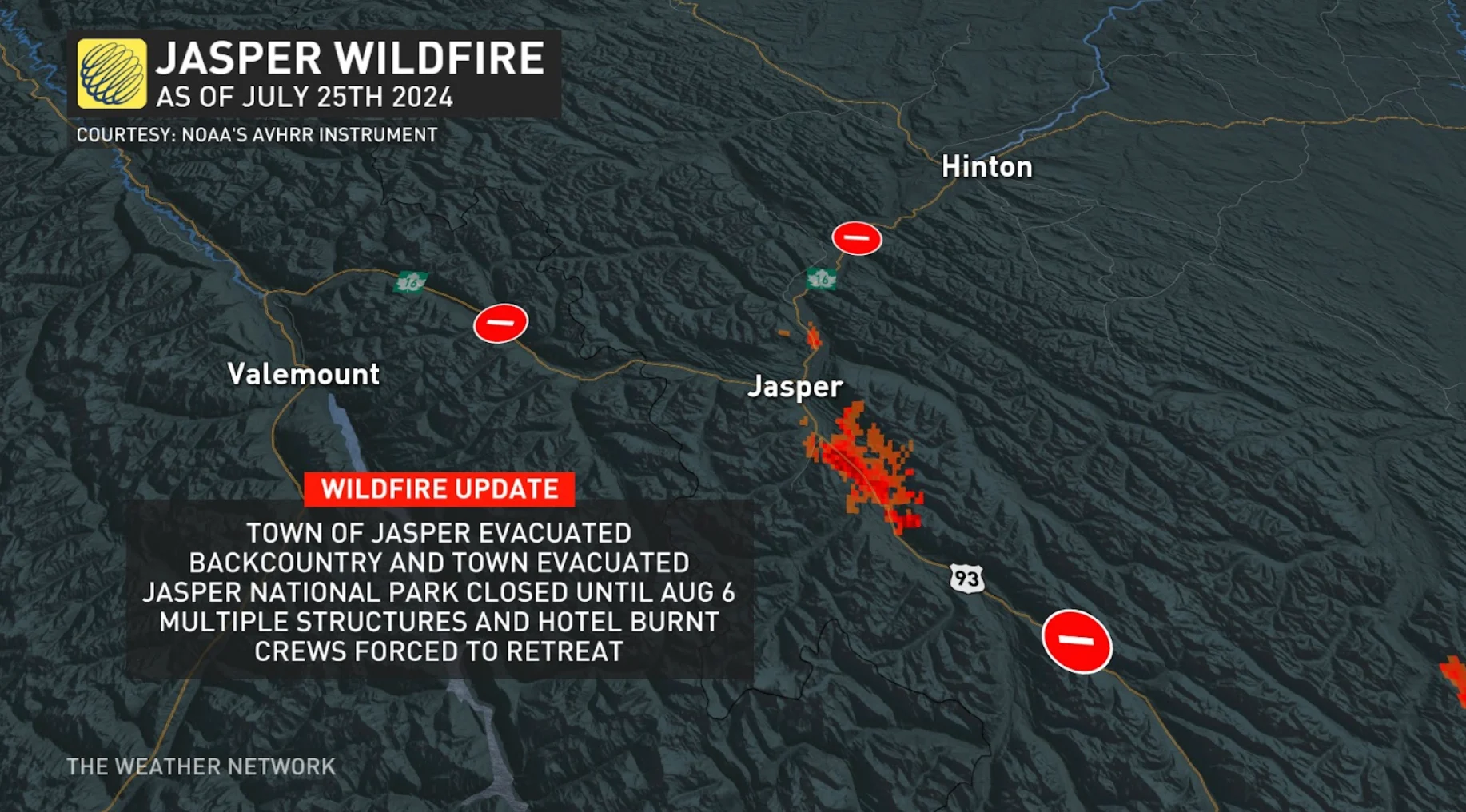
(NOAA/The Weather Network)
Park officials say numerous buildings in the historic townsite in the heart of Jasper National Park have been lost.
Images and videos shared overnight on social media showed multiple buildings, including homes and businesses, consumed.
Photographs shared by firefighters from Woodlands County, who were called in to assist in the response, show other buildings gutted by fire, including the Jasper Anglican Church, a historic Gothic heritage building also known as the St. Mary and St. George Parish.
Critical infrastructure, including the wastewater treatment plant, the hospital, communications facilities and the Trans Mountain Pipeline were among the buildings under threat Wednesday.

RELATED: Does breathing in wildfire smoke mean lung issues for life?
In a public statement to residents Thursday morning, Jasper Mayor Richard Ireland said crews continue to fight the flames and protect the community.
He said council will continue to work with all levels of government to co-ordinate relief efforts and supports for thousands of evacuees now dispersed across Western Canada.
Ireland expressed his grief at the damage caused and urged the people of Jasper to lean one another as they grieve.
He said residents are just starting to come to terms with the devastating impact of the disaster and the challenges that lie ahead.
During a news conference Thursday, Ireland urged residents to have patience as they wait for answers on what is left standing in Jasper. The continuing fight against the fire must take precedence, he said.
He said the scale of tragedy faced by the community is almost incomprehensible.
"As this wildfire continues to rage, there are other priorities for those on the ground. And so I accept that some of those details simply will have to wait until later."
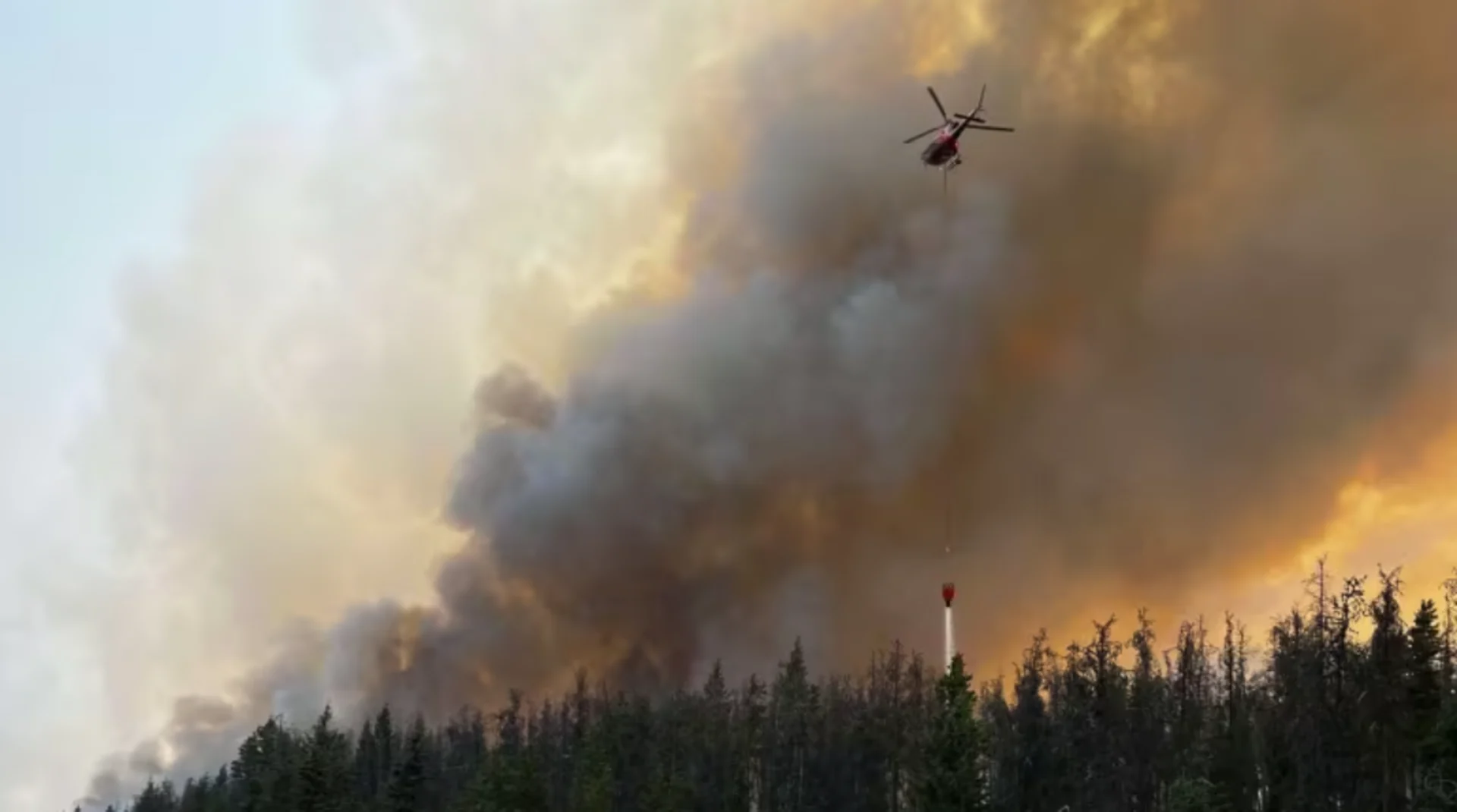
A wildfire south of Jasper's townsite prompted an evacuation order Monday night. (Submitted by Trina Pelland Taylor)
In a statement Thursday, Parks Canada said firefighting efforts continue. Rain has helped but it has not been enough to bring the flames under control.
No injuries have been reported but the situation remains volatile.
"Due to the ongoing fire conditions and our focus on the response effort, it is impossible to share information about specific locations and the extent of damage at this time," the statement said.
"While we understand people are desperate to know about the status of our community, homes, work places, businesses, and cherished places we will need some time to stabilize this incident as we access and assess structures."
WATCH: Jasper evacuees campout in B.C. as fires continue to rage
SEE ALSO: Best practices to keep yourself safe from wildfire smoke
Crews continue to fight save as many buildings as possible. And the fight has been a battle waged on numerous fronts.
Jasper was under threat from the north and south, and mandatory evacuation orders were issued Monday as the fires flared, forcing as many as 25,000 residents and visitors out.
The northern fire was spotted five kilometres from Jasper earlier Wednesday but continued to draw closer to the town. The southern fire had been reported eight kilometres out from town but within a matter of hours, it had reached the outskirts of the community.
The situation only grew worse as the hours passed.
Bucketing efforts by helicopters failed. Crews using heavy equipment to build fireguards couldn't complete the work before having to pull back for safety.
Water bombers couldn't help due to dangerous flying conditions.
A last-ditch effort to use controlled burns to reroute the fire to natural barriers like Highway 16 and the Athabasca River failed.
First responders were eventually forced out of town.
Only structural firefighters equipped with personal respirators remained.
"The fire made a significant push driven by winds and very receptive fuels," Eastham said. "The fire came into town very quickly."
Weeks of relentless heat made for tinder-box conditions in the forest, a volatile mix of extremely dry fuels that fed the flames toward the community, he said.
WATCH: How does this Canadian fire season compare to 2023?
When the flames reached the townsite, it was an impossible battle, even with hundreds of people and machines on the ground and in the sky working to safeguard the community, Eastham said.
"We got as many resources as we were able to here as fast as we could to respond to this fire," he said.
"Unfortunately, given the conditions and given the fire behaviour today, there was nothing that those resources could do to prevent the spread of the fire into the town."
The forecast for Thursday offers some promise of relief for beleaguered crews.
Mike Flannigan, the B.C. innovation research chair in predictive services, emergency management and fire science at Thompson Rivers University, said the fire was so intense it likely created its own weather system.
When fires burn hot and fast enough, the clouds generated from the heat and combustion on the ground below, create a firestorm that can trigger various meteorological conditions, including thunder, lightning and wind.
These systems, known pyrocumulonimbus, only develop during the most volatile and intense fires, Flannigan said.
"The fuels were right and the conditions were extreme," he said. "It was such a high-intensity fire and the winds were pushing it up the valley, and fires love to run up and down valleys.
"It was just a tragedy to see it happen."

The Maligne Lodge hotel is one of the structures that burned in Jasper, Alta., after a wildfire reached the townsite Wednesday evening. (Submitted)
Flannigan expects calmer wildfire conditions will prevail Thursday, thanks to calmer winds, elevated humidity and rain.
According to Environment Canada, showers began overnight and heavy rainfall is expected in the region.
Up to 30 mm of rain is expected to fall Thursday, a marked change following a few weeks of extremely hot and incredibly dry weather across the province.
Eric Van Lochem with Environment Canada said some showers began falling overnight but getting accurate data from Jasper is challenging as the weather station for the community has been down since Wednesday night. He couldn't say if the weather station was damaged in the fire.
WATCH: Thousands evacuate Jasper as a dangerous wildfire burns
The provincial government has asked Ottawa for more firefighting resources, aerial support to move crews and equipment and help evacuating remote communities.
In a post to social media late Wednesday, Prime Minister Justin Trudeau said Ottawa had approved Alberta's request for federal assistance and that the federal government was "mobilizing every necessary resource available."
This article, written by Wallis Snowdon, was originally published for CBC News.









